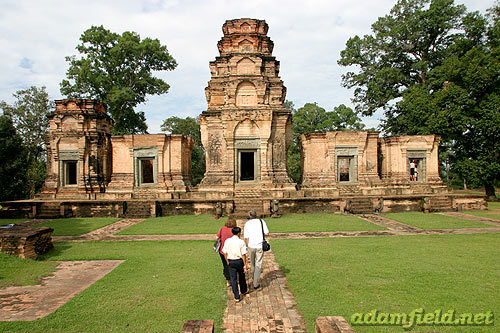
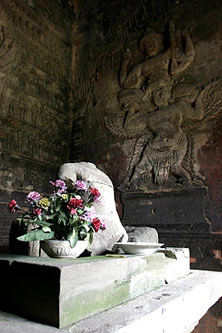
| [ Home ] | [ Photo Diary ] | [ Image Gallery ] | [ Contact Me ] |
The travel time from my apartment in Daejeon to Vaessna's, a little eatery in Siem Reap, was around 13 hours. It was great to sit down and have a cup of tea, and the spicy chicken soup was wonderful. The plane touched down as the sun was setting, so by the time I cleared customs it was too dark to see anything. I got tantalising glimpses of silhouettes on the skyline on the ride into town, which whetted my appetite for exploring the on the following day. I had taken a scooter from the airport into the town, and my driver, a fine young man named Chheoum, had offered his services for the next two or three days. He picked me up at 8 the next morning and we were off to see the temples.
 |
| Prasat Kravan used to contain a phallic symbol in the central tower where a headless Buddha now sits (right). The open top of the temple allowed rainwater to collect, the drinking of which was said to improve fertility. |
 |
Our first stop was Prasat Kravan. We pulled up into the carpark and a flock of souvenir sellers converged on us. My short walk from the bike to the temple was almost a battle. The sellers were mainly children and had learned the art of conveying that if I didn't buy from them, they would take it very personally - perhaps they would even cry. They respected the boundary of the temple however, and didn't follow me past the moat. The temple was pretty small, consisting of a series of low walls and five small towers. Nothing to write home about, but a good way to whet my appetite for the temples to come without overwhelming me at the first hurdle.
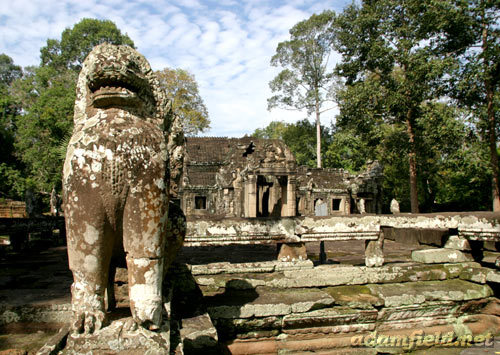 |
| A lion stands guard at the entrance to Banteay Kdei (top), a quiet sprawling temple with impressive carvings (bottom). |
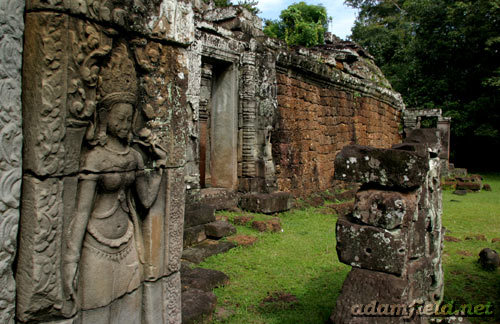 |
A short ride up the road brought me to Banteay Kdei, a temple surrounded by a massive wall 700m long and 500m wide. Gates set into the wall at all four compass points gave me my first look at the massive stone heads that these temples are known for. The temple itself was in a run-down state, the jungle eating away at it, but the carvings were impressive, and in nooks throughout the temple Buddha statues with saffron robes gazed peacefully out on me - a reminder that these temples remain a place of worship.
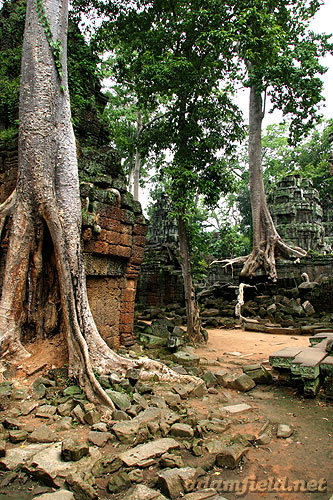 |
| Age old trees grow in the even older ruins of Ta Prohm, where the Jungle has been allowed to continue eating the temple. |
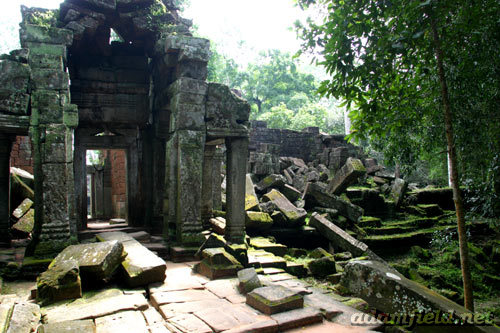 |
If I had to choose three unmissable temples, Ta Prohm, the next on the itinerary, would be one of them. Surrounded by another huge wall with giant heads over the gates, this temple is the stuff that adventures are made of. Little restoration work has been done to it, and there's no doubt that the Jungle is King here. Massive tree roots snake through the huge stone blocks, and many of the passages are impassible due to collapse. I spent a couple of hours wandering around, but barely scratched the surface. I put some effort into finding parts of the temple where there were no other people, and the experience of walking alone through mossy stone blocks toppled by the growth of the jungle was incredible. It was like I was the first person ever to walk there: It was I who had just discovered this temple.
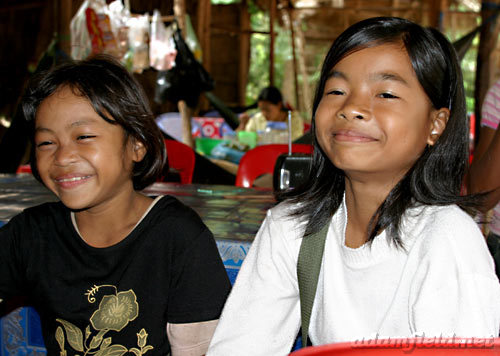 |
| Could you say no? Two beautiful souvenir sellers sit in a restaurant outside Ta Prohm. |
I ate in one of the eateries outside Ta Prohm, and while waiting wrote some postcards home despite the continual, though not completely unpleasant, distraction of the handful of young hawkers trying to sell souvenirs. I guess there are rules they have to follow because as soon as my food arrived they stopped pestering me, but once I'd taken my last bite the sales pitch started up again with renewed fervor.
 |
| Ta Keo, a pyramid which demonstrates the Angkorean fixation on representing mountains with their architecture. |
Merely because it was on the route, we stopped at Ta Keo, a 1000 year old, 50 meter high pyramid. This was the first temple that did not totally eclipse the previous one. That said, it was a departure from the style I had observed until that point. Angkorian temples are all symbolic of Mt Meru, the home of the Hindu Gods. No courtyards and passageways in this temple, that it resembled a mountain was inescapable. I climbed the mountain, which was a sweaty task in the heat and humidity, but was disappointed by the view from the top.
 |
| The East Wall and Victory Gate of Angkor Thom. |
Angkor Thom is the walled city of Jayavarman VII, Angkor's greatest king. The wall forms a perfect square, about three kilometers (2 miles) on each side, with a gate in the centre of each side, and an additional gate, the Victory Gate, in the eastern wall. It was through this gate that I entered. The four faces that topped the gate were at least five meters from chin to brow. After passing through the gate we traveled for over a kilometer before we saw anything other than jungle, then we came to the crossroads in the centre of Angkor Thom.
 |
| The Bayon, with it's myriad of faces, appears to be an uninspiring ruined temple until you get up close and the faces reveal themselves. |
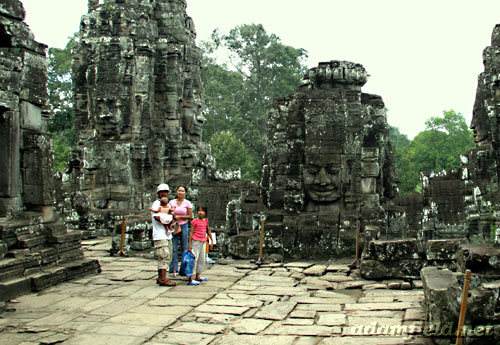 |
It is in the exact centre of Angkor Thom that my second choice for 'unmissible temple' resides. The Bayon, which at a distance looked like a pile of rubble, turned into one of the most amazing things I have ever seen as I got closer. The spires of the temple had huge faces on them. Exploring the temple was an amazing experience. Every time I turned a corner, more faces appeared, and the walls were covered with intricate carvings. Saffron robed monks wandered around the structure and schoolchildren were sitting in groups drawing pictures of the temple, the faces and the carvings.
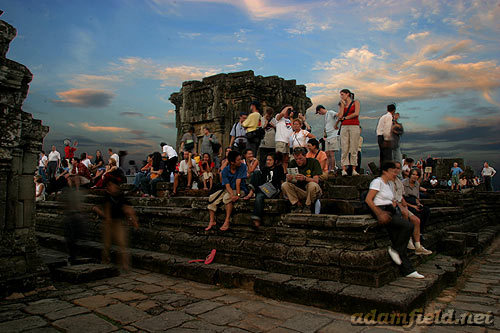 |
| Tourists wait for the sunset at Phnom Bakheng, a temple mountain on top of a steep hill. |
After a snack we moved on to the final stop for the day, Phnom Bakheng. This is a popular spot for sunset as there's a great view of the jungle. It was a steep climb up the hill, then a steeper climb up the temple, for what turned out to be a rather disappointing sunset. There was too much cloud near the horizon. Walking down the hill in the dark with two camera bags and a tripod was a trifle dangerous to say the least, but I relocated my driver eventually. We arranged to meet at 5am the next day when he dropped me back at the hotel. I washed my clothes in the sink and hung them out before going to bed. They never did dry properly.